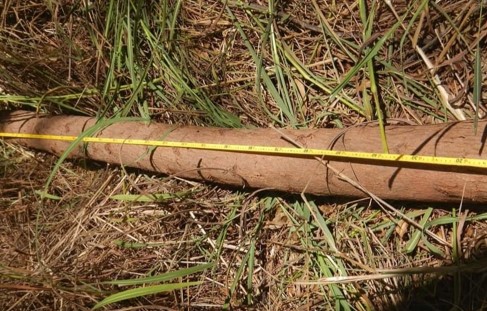Volumetric equations for Eucaliptus sp in the cerrado tocantinense
DOI:
https://doi.org/10.20873/jbb.uft.cemaf.v9n3.santanaKeywords:
hard composting, forest inventory, eucalyptusAbstract
The objective of this work was to select volumetric equations for GG-100, VM-58 and seminal Eucalyptus clones, in Aliança, south of the state of Tocantins. Data were collected in a 7-year-old Eucalyptus plantation with a spacing of 2.5m x 4.0m (1,000 trees/ha). The selection of trees for cubage was carried out from a systematic forest inventory and stratified by clone and seminal for later determination of the diameter distribution. Cubing was performed using the Smaliam method on 48 trees with DBH ≥ 12 cm until the entire diameter distribution was covered. 10 traditional mathematical models were adjusted for each species of eucalyptus. The best fitted models for each species were determined through the values of R2aj and CV (%) together with the graphical analysis of residues. The best models were: lnv=-11.6833+1.4379*lnd+1.9246*lnh (Schumacher Hall) for VM-58 with the R2aj =0.88 and CV% =5.00, the lnv= model 6.6775+1.7840*lnd (Husch) for GG-100 with R2aj= 0.77 and CV%= 34.89 and lnv=-9.6711+2.8759*lnd+0.0762*lnh (Schumacher Hall) for Seminal, with R2aj= 0.91 and CV%= 10.12. Through the tukey test, no significant difference was observed in the DAP and volume variables between the clones.
References
Amorim DM. Fator de forma artificial para o híbrido Eucalyp-tus urophylla vs Eucalyptus grandis na Amazônia Oriental. 2014. Monografia (Graduação em Engenharia Florestal) Universidade Federal do Pará, Altamira, 2014.
Azevedo TL, Mello AAD, Ferreira RA, Sanquetta CR, Naka-jima NY. Equações hipsométricas e volumétricas para um povoamento de Eucalyptus sp. localizado na FLONA do Ibura, Sergipe. Revista Brasileira de Ciências Agrárias, 6 (1): 105-122p. 2011. https://doi.org/DOI:10.5039/agraria.v6i1a861
Batista JLF, Couto HTZ, Marquesini M. Desempenho de modelos de relações hipsométricas: estudo em três tipos de floresta. Scientia Forestalis, 1 (60): 143-163p.2001.
Campos JCC, Leite HG. Mensuração florestal: perguntas e respostas. Minas Gerais: Viçosa. 94p.2009.
Carvalho M, Rosa M, Lima G, Koehler, HS, Nappo ME. Comparação dos métodos de cubagem na determinação do volume de árvores de Eucalyptus urophylla x Eucalyptus grandis. Atualidades em Mensuração Florestal. Paraná: Cu-ritiba. 50-54p.2014.
Cerdeira ALN. Modelos para quantificação do volume de diferentes sortimentos em plantio de Eucalyptus urophylla x Eucalyptus grandis. Monografia, Graduação Engenharia Florestal, Universidade de Brasília. 66p. 2013.
Cipriani HN, Vieira AH, Godinho VPC. Crescimento inicial de clones de eucalipto em Vilhena, RO. Porto Velho: EM-PRABA, 2013. (Comunicado Técnico, 388).
Draper NR, Smith H. Applied regression analysis. 3ª Edition. Canada: Wiley & Sons. 326p. 2014.
Finger CAG. Fundamentos de biometria florestal. Santa Ma-ria: Universidade Federal de Santa Maria. 269p.1992.
IBÁ. Indústria Brasileira de Árvores. São Paulo. 100p. 2017.
Machado SA, Urbano E, Conceição MB. Comparação de métodos de estimativa de volume para Pinus oocarpa em diferentes idades e diferentes regimes de desbastes. Pesquisa Florestal Brasileira, v.1, n.50, 81-98p.2005.
Mello JM. Geoestatística aplicada ao inventário florestal. Tese de Doutorado, Universidade de São Paulo, Piracicaba. 122, p.2004.
Menon MU. Ajuste dos modelos de Kozak e do sistema Murkhart e Cao para plantações de Pinus oocarpa. Revista Ambiência, 1: 197-205p.2005.
Miguel EP, Canzi LF, Rufino RF, Santos GD. Ajuste de modelo volumétrico e desenvolvimento de fator de forma para plantios de Eucalyptus grandis localizados no municí-pio de Rio Verde – GO. Enciclopédia Biosfera, 6 (11): 1-13p. 2010.
Miguel E P, Leal FA, Ono HA, Leal UAS. Modelagem na predição do volume individual em plantio de Eucalyptus urograndis. Revista Brasileira de Biometria, 32 (4): 584-598, p.2014.
Miranda RO, Ebling AA, David HC, Fiorentin LD, Soares ID. Efeito do método de amostragem da cubagem rigorosa na precisão de estimativas volumétricas. In: Atualidades em Mensuração Florestal. Curitiba: Paraná Brasil. 67-70p. 2014.
Santana OA, Encinas JI. Equações volumétricas para uma plantação de Eucalyptus urophylla destinada a produção de lenha. In: Simpósio latino-americano sobre manejo florestal. Santa Maria: UFSM/PPGEF. 107-111p. 2004.
Schneider PR, Schneider PS. Introdução ao manejo florestal. 2 Edition. Santa Maria: FACOS –UFSM. 566p. 2008.
SEPLAN – Secretária do Planejamento. Diretoria de Zonea-mento Ecológico- Economico Base de dados geográfico do TO. Palmas: Tocantins.2012.
Silva JAA, Paula NF. Princípios básicos de dendrometria. 1 Edition. Recife: Universidade Federal Rural do Pernambuco. 191p. 1979.
Thomas C, Andrade CM, Schneider PR, Finger CAG. Com-paração de equações volumétricas ajustadas com dados de cubagem e análise de tronco. Ciência Florestal, 16 (3): 319-327p. 2006.
Viera M, Schumacher MV, Trüby P, Araújo EF. Biomassa e nutrientes em um povoamento de Eucalyptus urophylla x Eucalyptus globulus, em Eldorado do Sul-RS. Revista Eco-logia e Nutrição Florestal-ENFLO, 1(1): 1-13p.2014.
Vital MHF. Impacto ambiental de florestas de eucalipto. Re-vista do BNDES, Rio de Janeiro, 14: 235-276p. 2007.

Downloads
Published
How to Cite
Issue
Section
License
Copyright (c) 2024 - Journal of Biotechnology and Biodiversity

This work is licensed under a Creative Commons Attribution 4.0 International License.
Authors who publish with this journal agree to the following terms:
Authors retain copyright and grant the journal right of first publication with the work simultaneously licensed under a Creative Commons Attribution License (CC BY 4.0 at http://creativecommons.org/licenses/by/4.0/) that allows others to share the work with an acknowledgement of the work's authorship and initial publication in this journal.
Authors are able to enter into separate, additional contractual arrangements for the non-exclusive distribution of the journal's published version of the work (e.g., post it to an institutional repository or publish it in a book), with an acknowledgement of its initial publication in this journal.
Authors are permitted and encouraged to post their work online (e.g. in institutional repositories or on their website) prior to and during the submission process, as it can lead to productive exchanges, as well as earlier and greater citation of published work (Available at The Effect of Open Access, at http://opcit.eprints.org/oacitation-biblio.html).


